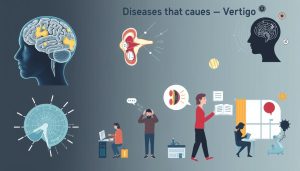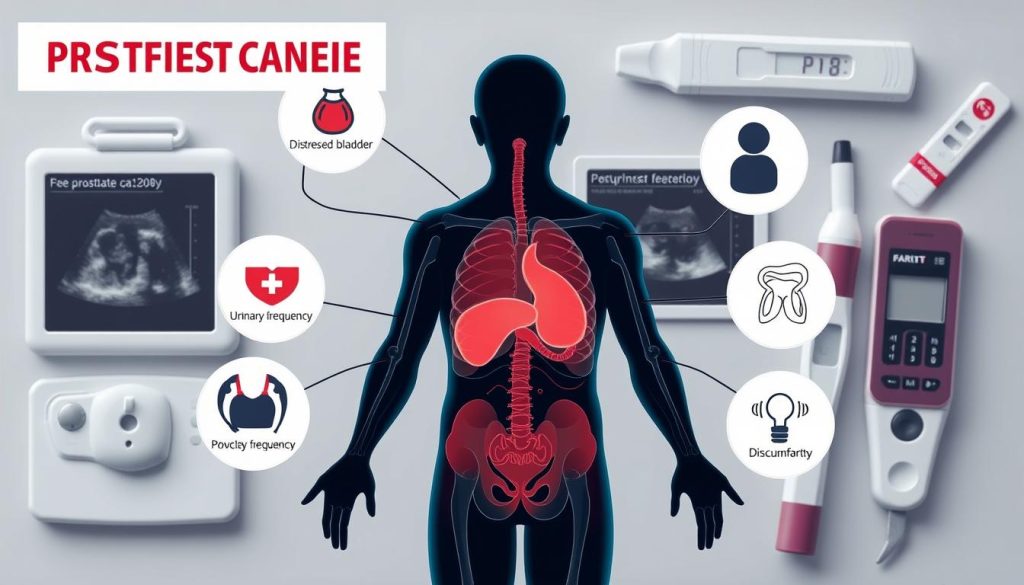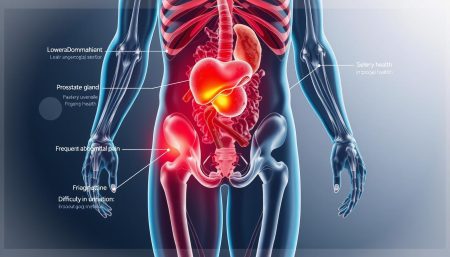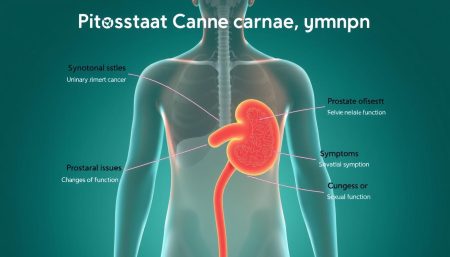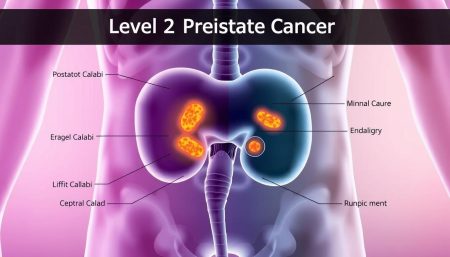Prostate cancer is a serious health concern for men. Knowing the signs early can greatly improve treatment outcomes. This guide will help you understand what to look for and when to seek medical help.
Prostate cancer symptoms can be subtle at first. They may include changes in urination habits or discomfort in the pelvic area. It’s important to be aware of these signs for early detection. Regular prostate cancer screening is also key, especially for men over 50 or those with higher risk factors.
Understanding your body and staying informed about prostate health can save lives. If you notice any unusual changes, don’t hesitate to talk to your doctor. Early detection through prostate cancer screening gives you the best chance for successful treatment.
Understanding Prostate Cancer and Its Impact on Men’s Health
Prostate cancer is a big health worry for men everywhere. It hits the prostate gland, a small but key part of male health. We’ll look at what prostate cancer is, how common it is, and why catching it early is so important.
What is the Prostate and Its Function
The prostate is a small gland, about the size of a walnut, below the bladder. It makes seminal fluid, which helps sperm. As men get older, the prostate can face health problems, like cancer.
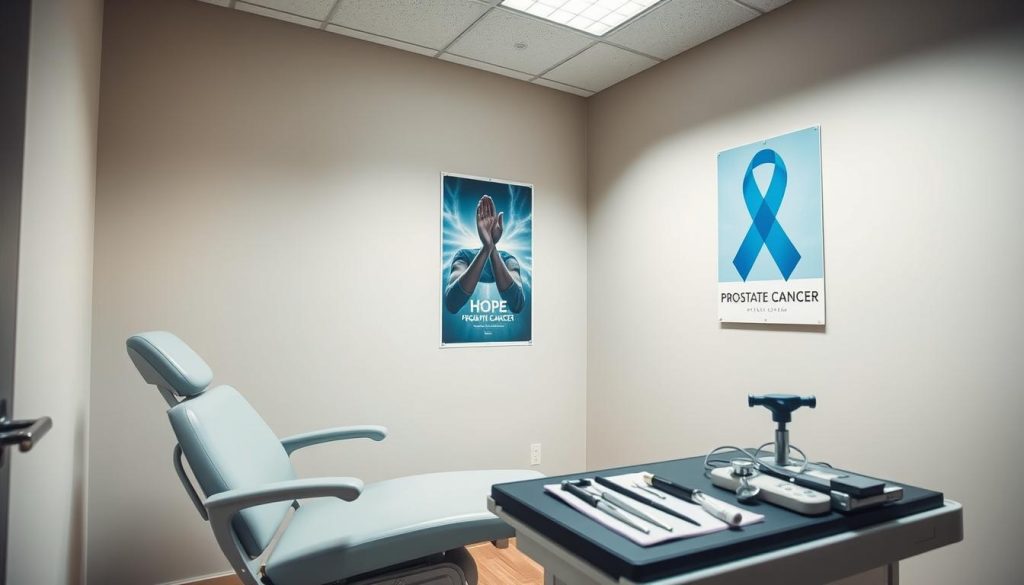
Demographics and Statistics of Prostate Cancer
Prostate cancer is the second most common cancer in men worldwide. In the U.S., about 1 in 8 men will get prostate cancer. Most cases happen in men over 50, making age a big risk factor.
| Age Group | Risk of Prostate Cancer |
|---|---|
| Under 50 | Low |
| 50-64 | Moderate |
| 65 and older | High |
Why Early Detection Matters
Early detection is key in fighting prostate cancer. If caught early, prostate cancer can be treated well. Regular check-ups and knowing the risks help prevent prostate cancer. Early diagnosis means better treatment and survival chances.
“Catching prostate cancer early can make all the difference. Don’t wait for symptoms to appear before getting checked.”
Knowing about prostate cancer helps men take care of their health. By learning about risks and prevention, men can work with doctors to create screening plans that fit them.
How Can U Tell If U Have Prostate Cancer
Spotting prostate cancer early is vital for good treatment. Men should know the signs that might show they have it. Let’s look at the main signs and physical changes to watch for.
Early Warning Signs and Symptoms
Prostate cancer signs often start slowly and might not be easy to notice early. Some common symptoms include:
- Frequent urination, especially at night
- Difficulty starting or stopping urination
- Weak or interrupted urine flow
- Painful or burning sensation during urination
- Blood in urine or semen
- Painful ejaculation
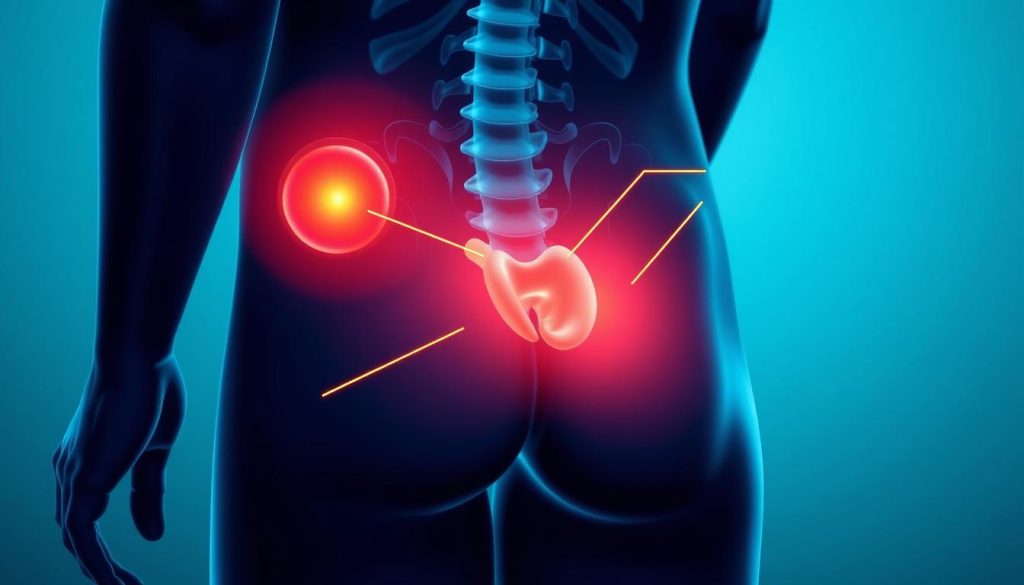
Physical Changes to Watch For
As prostate cancer gets worse, you might see physical changes. These can include:
- Unexplained weight loss
- Bone pain, especially in the hips, spine, or ribs
- Swelling in the legs or pelvic area
- Erectile dysfunction
When to Contact Your Healthcare Provider
If you notice any of these symptoms or physical changes, see your doctor. These signs don’t always mean you have prostate cancer, but they need checking. Your doctor can run tests to find out what’s causing them and suggest what to do next.
| Symptom | Action |
|---|---|
| Persistent urinary changes | Schedule a check-up |
| Blood in urine or semen | Seek immediate medical attention |
| Unexplained bone pain | Consult your doctor promptly |
| Erectile dysfunction | Discuss with your healthcare provider |
Early detection is crucial for treating prostate cancer well. If you’re wondering how to tell if you have prostate cancer, watch for these signs. And don’t hesitate to get medical advice.
Common Risk Factors for Prostate Cancer Development
Knowing about prostate cancer risk factors is key to preventing and catching it early. Age is a big factor, with men over 50 at higher risk. If your family has a history of prostate cancer, you’re more likely to get it too.
Race also plays a part. African American men are more likely to get prostate cancer than others. What you eat and how active you are can also affect your risk. Eating too much fat and not exercising can up your chances.
Being overweight can lead to more aggressive prostate cancer. Smoking harms your health and might increase your risk of prostate cancer. Exposure to chemicals like pesticides or heavy metals can also raise your risk.
| Risk Factor | Impact Level | Preventable |
|---|---|---|
| Age (over 50) | High | No |
| Family History | High | No |
| Race (African American) | High | No |
| Diet (High-fat) | Moderate | Yes |
| Lack of Exercise | Moderate | Yes |
| Obesity | Moderate to High | Yes |
| Smoking | Moderate | Yes |
| Chemical Exposure | Low to Moderate | Partially |
Regular health check-ups and screenings are crucial for preventing and catching prostate cancer early. Talk to your doctor about your risk factors to make a plan to stay healthy.
Essential Screening Methods and Diagnostic Tests
Early detection of prostate cancer is crucial for effective treatment. Doctors employ various prostate cancer tests to identify and diagnose this disease. Let’s delve into the primary methods for detecting prostate cancer.
PSA Blood Test Explained
The PSA (Prostate-Specific Antigen) blood test is a common screening tool. It measures PSA levels in your blood. Elevated levels might suggest prostate cancer, but can also result from other conditions. Your doctor will consider your age and health history when interpreting the results.
Digital Rectal Examination (DRE)
During a DRE, your doctor examines your prostate through the rectum wall. They look for lumps, hard spots, or unusual textures. Although it’s not the most pleasant exam, it’s quick and offers important insights into your prostate health.
Advanced Imaging Techniques
If initial tests suggest concerns, your doctor might suggest advanced imaging. This could include:
- MRI scans
- CT scans
- Bone scans
These tests provide detailed images of your prostate and help check if cancer has spread.
Prostate Biopsy Process
A prostate biopsy is the definitive way to confirm prostate cancer. It involves removing small samples of prostate tissue for microscopic examination. Although it may seem intimidating, it’s usually done with local anesthesia and is essential for accurate diagnosis.
These prostate cancer screening methods work together to give a comprehensive view of your prostate health. Regular screening can significantly improve treatment outcomes by catching cancer early.
Treatment Options and Modern Approaches
Prostate cancer treatment has made great strides, offering hope to many men. The right treatment depends on the cancer’s stage and the patient’s health. Doctors now have many tools to fight this disease.
New treatments like targeted therapies and immunotherapy are changing the game. These methods aim to reduce side effects while being effective. It’s important to talk to your doctor about these options to find the best plan for you.
Preventing prostate cancer is also key. Eating well and exercising can lower your risk. Regular screenings can catch cancer early, leading to better treatment choices.
Every case of prostate cancer is different. What works for one person might not work for another. By staying up-to-date on treatments and working with your doctor, you can make the best choices for your health.
FAQ
Q: What are the early warning signs of prostate cancer?
A: Signs of prostate cancer include frequent urination, especially at night. You might also notice weak or interrupted urine flow. Difficulty starting urination and blood in urine or semen are other signs.
Erectile dysfunction and pain in the pelvic area can also be symptoms. But, these signs can also mean other health issues. So, it’s key to see a doctor for a proper check-up.
Q: At what age should men start screening for prostate cancer?
A: Men should talk to their doctor about prostate cancer screening at age 50 if they’re at average risk. African American men or those with a family history of prostate cancer should start at 45. Some men with very high risk might need to start at 40.
Q: What is a PSA test, and how is it used in prostate cancer screening?
A: A PSA test is a blood test that checks for prostate-specific antigen (PSA) levels. High PSA levels can mean prostate cancer. But, other health issues can also raise PSA levels.
This test is usually part of a bigger screening plan. It helps decide if more tests, like a biopsy, are needed.
Q: What are the main risk factors for developing prostate cancer?
A: Risk factors for prostate cancer include age and race. African American men face a higher risk. Family history, genetic mutations, and lifestyle factors like obesity and smoking also play a role.
But, having a risk factor doesn’t mean you’ll definitely get prostate cancer.
Q: How accurate is a digital rectal exam (DRE) in detecting prostate cancer?
A: A digital rectal exam (DRE) can find prostate problems but isn’t very accurate for cancer. It’s best when used with a PSA test. The DRE can spot irregularities in the prostate.
But, many early-stage cancers can’t be felt during a DRE.
Q: What are the stages of prostate cancer?
A: Prostate cancer is staged from I to IV. Stage I is early cancer in the prostate. Stage II is more advanced but still in the prostate.
Stage III means the cancer has spread but not to distant parts of the body. Stage IV is when cancer has spread to distant areas. The stage helps choose the best treatment.
Q: Can prostate cancer be prevented?
A: There’s no sure way to prevent prostate cancer. But, healthy lifestyle choices can lower your risk. Eating well, exercising, and avoiding smoking are good choices.
Some studies suggest certain medications might help. But, they can have side effects and should be discussed with a doctor.
Q: What treatment options are available for prostate cancer?
A: Treatment options depend on the cancer’s stage, your health, and what you prefer. Options include active surveillance, surgery, radiation, hormone therapy, and chemotherapy.
Newer treatments like cryotherapy and high-intensity focused ultrasound (HIFU) are also available. The best treatment plan is decided with a healthcare team.




